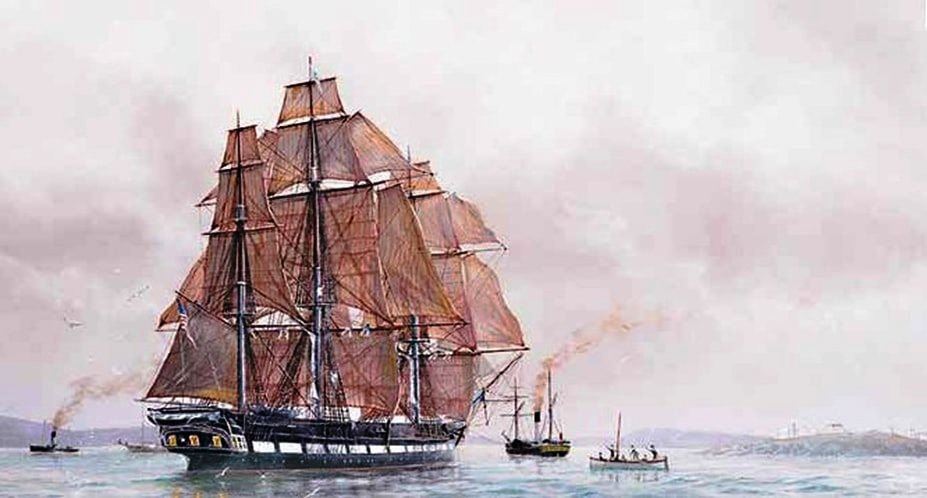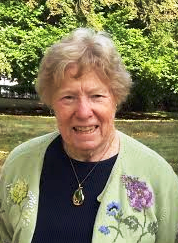|
 Sketch of the USS Jamestown by E.D. Walker, Marine Artist
Sketch of the USS Jamestown by E.D. Walker, Marine Artist
‘With Good Will Doing Service’ defines The Charitable Irish Society of Boston
By Catherine B. Shannon
The Early Years l737 to l837
The Charitable Irish was founded in l737 by twenty-six men of Ulster birth and ancestry for the purpose of providing for “relief of poor, aged and infirm persons, such as have been reduced by sickness, shipwreck and other accidental misfortunes.” A secondary purpose of the society was to cultivate a spirit of unity and harmony among all resident Irishmen and their descendants in the Massachusetts colony and “to advance socially and morally the interests of the Irish people.” The motto attached to the founding articles was “With Good Will Doing Service,” and for the past 274 years, the society has remained true to this motto of doing service to fellow Irish men and women, its ancestral land as well as to its American homeland.
The founders, who were predominantly Presbyterians, represented a variety of occupations, including merchants, lawyers, teachers, a sea captain, a joiner, a constable, and the proverbial “retailer of strong drink.” The original initiation fee was ten shillings, or the equivalent of $500 today, and dues were 8 shillings annually, the equivalent of $400 today. Annual meetings were held in April and a dress code prohibited members from wearing ‘cap or apron’ at this event, and meetings were to be concluded by 2 a.m. By 1800, the annual meetings were held on March l7 and clearly identified with Ireland’s national patron, St. Patrick. The Keeper of the Silver Key oversaw recruitment and membership. The Keeper’s authority was symbolized by his possession of the Silver Key, which was crafted from an ordinary contemporary key and a l738 King George II Irish coin. The coin bears the crowned harp on one side and the head of King George II on the other. Jacob Hurd, one of the most accomplished silversmiths in colonial Boston, designed and crafted the key. His hallmark is still visible on the key and replicates those on Hurd’s other works that reside in the Museum of Fine Arts colonial silver collection.
Another notable early member was Patrick Tracey, a sea captain from Newburyport, who emigrated from Wexford in l736, and quickly acquired great wealth. He operated a fleet of privateers during the Revolutionary War and captured 2,000 British prisoners. His grandchildren became prominent in Boston, one founding the Massachusetts General Hospital, another becoming Chief Justice of the Massachusetts Supreme Judicial Court, and another developing the first fully mechanized cotton mill in Waltham, and other mills in Lowell. Twentieth century Tracey descendants included Governor Francis Sargent and US Attorney General Elliot Richardson, both of whom were CIS members. Another CIS member who supported the revolutionary cause was General Henry Knox, who orchestrated the delivery of the guns from Fort Ticonderoga to Dorchester Heights, enabling General George Washington to threaten the British fleet and thereby effect the British evacuation from Boston on l7 March l776.
The CIS is unique among Irish American associations for its long-standing inclusive tradition of having both Protestant and Catholic members and assisting people of both religions. In l760, the society dropped the qualification of being Protestant sixty years before religious disqualifications against Roman Catholics holding public office in the Commonwealth were abolished. In fact, one of its members, Samuel L. Knapp, took a leading role in getting the Massachusetts Legislature to remove the ban on Catholics holding public office in 1820. Knapp served as president of the society in 1824-25. The society’s commitment to inclusiveness was also reflected in its two invitations to Boston’s first Catholic bishop, Jean Cheverus, to address the society in 1805 and 1817. The bishop recognized the society’s good work, and on one occasion transferred all of the proceeds of the March 17 Cathedral of the Holy Cross collection to the Charitable Irish Society to disperse to the needy. Despite the religious tensions of the l830s that were evidenced by the burning of the Ursuline Convent in 1834 and the Broad Street riots three years later, in his 1837 centenary speech CIS President James Boyd, who was a Protestant, welcomed the growing number of Catholics joining the organization. He also proposed toasts to the Irish Liberator Daniel O’Connell, who had successfully spearheaded the campaign for Catholic Emancipation in the l820s. Among the increasing number of Catholics who joined the CIS in this era was Bernard Fitzpatrick, who was the Society President in 1830 and the father of the future Boston Bishop John Fitzpatrick. Also joining was Rev. Thomas J. O’Flaherty who became CIS President in 1831 and is the only clergyman ever to hold that office.
The CIS’s Role
in Famine Relief Efforts l845 to 1851
When the arrival of the royal mail ship the RMS Britannia on Nov. 20, 1845, brought news of the initial potato crop failure in Ireland, the Charitable Irish Society responded quickly and generously at both the individual and organizational level. Former President Rev. Thomas J. O’Flaherty established the Irish Charitable Fund, which was the first formal response in the nation to the bleak news from Ireland. In just nine days, O’Flaherty raised $1,000 and the local Repeal Association collected $2,114 from Irish laborers. Before the year’s end, $19,000 was collected for Irish relief in the City of Boston.
There were no organized relief efforts in the city in the first half of l846 because subsequent potato crop failures were not anticipated and the British government had bought substantial quantities of American corn to sell at moderate prices in the event of another crisis. However, the arrival of the RMS Hibernia on January 25, 1847, confirmed earlier autumn reports of impending starvation in Ireland because of the total failure of the l846 potato crop. CIS members and other concerned Bostonians redoubled their earlier efforts to send relief. On February 7, Bishop John Fitzpatrick, whose father was a society member, launched a pastoral appeal to all parishes in the dioceses and within six weeks, he sent $24,000 via the RMS Cambria to Archbishop Crolly in Armagh. Andrew Carney, a CIS member and the founder of Carney Hospital, was the treasurer of Fitzpatrick’s fund and personally contributed $1,000 at its launch. Rev. James O’Reilly of Boston, raised $1,300 in cash and $700 in pledges in just one day. When the Hibernia left Boston for Ireland in early February, it carried $72,000 in relief aid.
The city’s Brahmin elite responded to the shocking news from Ireland and joined the fund-raising efforts initiated by the city’s Irish community. On February 18, some 4,000 people attended a public meeting at Faneuil Hall that resulted in the formation of the New England Relief Committee. CIS members Andrew Carney and Patrick Donahoe of the Boston Pilot and a dozen other members cooperated closely with this body to raise funds. Within days of the Faneuil Hall meeting, Captain Robert Bennet Forbes and his brother John successfully petitioned Congress and secured the release of two US naval sloops lying idle in Boston and New York for shipment of food and supplies to Ireland. Members of the Charitable Irish Society participated in a citywide effort that eventually netted 800 tons of provisions and supplies worth $35,000 that were shipped to Cork on the USS Jamestown. Members of the Boston Laborers Society, mostly native-born Irishmen, began loading the vessel free of charge on St. Patrick’s Day. Meanwhile, the Charitable Irish Society cancelled its annual St. Patrick’s Day dinner and donated its expected dinner receipts to the USS Jamestown effort. Captain Forbes and all the ships’ officers undertook the voyage without any pay, and the crews’ wages were secured by public donations from Boston and the region.
After a record-breaking 15-day crossing, the Jamestown was greeted jubilantly when it arrived in Cobh on April 12. Captain Forbes was horrified by the conditions that he saw in Cork and the surrounding area and as soon as he returned to Boston, he used his influence to cut through the red tape that was delaying the sailing of the USS Macedonian from New York. He organized a Boston Macedonian Committee and when that ship landed at Cobh on July 28, its cargo included 5,000 barrels of corn that Bostonians had donated. The efforts of Captain Forbes and Bostonians were recognized by testimonials he received from the corporations of Cork and Dublin as well as a gift of a beautiful engraved silver tray still proudly displayed at the Forbes Museum in Milton. Captain Forbes’s heroic stature in Cork is also reflected in the square in Cork city that bears his name. In total, the New England Relief Committee sent $151, 000 of the total of more than $300,000 in relief that went from Boston to Ireland in l847. The equivalent of the last figure in today’s currency would be approximately $820,000.
Although such citywide ecumenical relief efforts waned after l847, Boston’s Irish community knew first-hand the challenges facing the impoverished Irish immigrants who arrived in Boston, especially after l847. The Immigrant Aid Society was established in 1850 to meet the needs of these new arrivals. By year’s end this society was placing 100 Irish girls per day as domestic servants in the city and providing approximately $1 per day or twice the daily laboring wage to those in need. The Charitable Irish Society cooperated with this organization and gave $300 annually for immigrant relief over the next seven years.
During its first century of existence and certainly during the famine era, the Charitable Irish Society and its individual members exhibited a constant commitment to its motto of “With Good Will Doing Service.”
* * * *

Catherine
B. Shannon is a Professor Emerita of History at Westfield State
University. She was the first woman president of the Charitable Irish
Society, serving in 1990 and 1991.
-page-001.jpg)